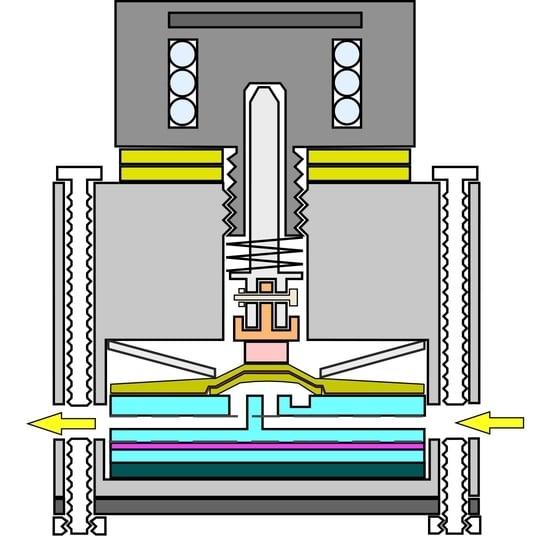A Microvalve Module with High Chemical Inertness and Embedded Flow Heating for Microscale Gas Chromatography
Abstract
:1. Introduction
1.1. Motivation and Need
1.2. Current State-of-Art
2. Device Structure and Operation
2.1. Device Structure and Fabrication
2.2. Operation
3. Modeling Results
4. Experimental Results
4.1. Flow Conductance Tests
4.2. Dynamic Response Test
4.3. Power and Energy Consumption
4.4. Lifetime Test
4.5. Chemical Injection Tests
5. Conclusions
Author Contributions
Funding
Institutional Review Board Statement
Informed Consent Statement
Data Availability Statement
Acknowledgments
Conflicts of Interest
References
- Terry, S.C.; Herman, J.H.; Angell, J.B. A gas chromatographic air analyzer fabricated on a silicon wafer. IEEE Trans. Electron. Devices 1979, 26, 1880–1886. [Google Scholar] [CrossRef]
- Park, J.M.; Taylor, R.P.; Evans, A.T.; Brosten, T.R.; Nellis, G.F.; Klein, S.A.; Feller, J.R.; Salerno, L.; Gianchandani, Y.B. A piezoelectric microvalve for cryogenic applications. J. Micromech. Microeng. 2008, 18, 015–023. [Google Scholar] [CrossRef]
- Park, J.M.; Evans, A.T.; Rasmussen, K.; Brosten, T.R.; Nellis, G.F.; Klein, S.A.; Gianchandani, Y.B. A microvalve with integrated sensors and customization normal state for low-temperature environment. J. Microelectromech. Syst. 2009, 18, 868–877. [Google Scholar] [CrossRef]
- Yang, X.; Holke, A.; Jacobson, S.A.; Lang, J.H.; Schmidt, M.A.; Umans, S.D. An electrostatic, on/off microvalve designed for gas fuel delivery for the MIT microengine. J. Microelectromech. Syst. 2004, 13, 660–668. [Google Scholar] [CrossRef]
- Hesketh, P.J.; Bintoro, J.S.; Luharuka, R. Microvalve for fuel cells and miniature gas chromatographic system. Sens. Update 2004, 13, 233–302. [Google Scholar] [CrossRef]
- Wang, J.; Chen, Z.; Mauk, M.; Hong, K.-S.; Li, M.; Yang, S.; Bau, H.H. Self-actuated, thermo-responsive hydrogel valves for lab on a chip. Biomed. Microdevices 2005, 7, 313–322. [Google Scholar] [CrossRef] [PubMed] [Green Version]
- Subramani, B.G.; Selvaganapathy, P.R. A versatile microreactor platform featuring a chemical-resistant microvalve. J. Micromech. Microeng. 2006, 16, 1433–1443. [Google Scholar]
- Evans, A.T.; Chiravuri, S.; Gianchandani, Y.B. A multidrug delivery system using a piezoelectrically actuated silicon valve manifold with embedded sensors. J. Microelectromech. Syst. 2011, 20, 231–238. [Google Scholar] [CrossRef]
- Popiel, S.; Witkiewicz, Z. Chemical warfare agents: GC analysis. In Encyclopedia of Chromatography, 3rd ed.; Cazes, J., Ed.; CRC Press: Boca Raton, FL, USA, 2009; pp. 396–402. [Google Scholar]
- Brown, M.A.; Brix, K.A. Review of health consequences from high-, intermediate- and low-level exposure to organophosphorus nerve agents. J. Appl. Toxicol. 1998, 18, 393–408. [Google Scholar] [CrossRef]
- Mitchell, M.B.; Sheinker, V.N.; Mintz, E.A. Adsorption and decomposition of dimethyl methylphosphonate on metal oxides. J. Phys. Chem. 1997, 101, 11192–11203. [Google Scholar] [CrossRef]
- Lewis, P.R.; Manginell, R.P.; Adkins, D.R.; Kottenstette, R.J.; Wheeler, D.R.; Sokolowski, S.S.; Trudell, D.E.; Byrnes, J.E.; Okandan, M.; Bauer, J.M.; et al. Recent advancements in the gas-phase MicroChemLab. IEEE Sens. J. 2006, 6, 784–795. [Google Scholar]
- Zampolli, S.; Elmi, I.; Mancarella, F.; Betti, P.; Dalcanale, E.; Cardinali, G.C.; Severi, M. Real-time monitoring of sub-ppb concentrations of aromatic volatiles with a MEMS-enabled miniaturized gas-chromatograph. Sens. Actuators B Chem. 2009, 141, 322–328. [Google Scholar] [CrossRef]
- Kim, S.K.; Chang, H.; Zellers, E.T. Microfabricated gas chromatograph for the selective determination of trichloroethylene vapor at sub-parts-per-billion concentrations in complex mixtures. Anal. Chem. 2011, 83, 7198–7206. [Google Scholar] [CrossRef] [PubMed]
- Garg, A.; Akbar, M.; Vejerano, E.; Narayanan, S.; Nazhandali, L.; Marr, L.C.; Agah, M. Zebra GC: A mini gas chromatography system for trace-level determination of hazardous air pollutants. Sens. Actuators B Chem. 2015, 212, 145–154. [Google Scholar] [CrossRef]
- Lee, J.; Zhou, M.; Zhu, H.; Nidetz, R.; Kurabayashi, K.; Fan, X. Fully automated portable comprehensive 2-dimensional gas chromatography device. Anal. Chem. 2016, 88, 10266–10274. [Google Scholar] [CrossRef]
- Seeley, J.V.; Micyus, N.J.; Bandurski, S.V.; Seeley, S.K.; McCurry, J.D. Microfluidic deans switch for comprehensive two-dimensional gas chromatography. Anal. Chem. 2007, 79, 1840–1847. [Google Scholar] [CrossRef]
- Collin, W.R.; Serrano, G.; Wright, L.K.; Chang, H.; Nunovero, N.; Zellers, E.T. Microfabricated gas chromatograph for rapid, trace-level determinations of gas-phase explosive marker compounds. Anal. Chem. 2014, 86, 655–663. [Google Scholar] [CrossRef]
- Gordenker, R.J.M.; Wise, K.D. A programmable palm-size gas analyzer for use in micro autonomous systems. In Proceedings of the SPIE Defense, Security, and Sensing, Baltimore, MD, USA, 23–27 April 2012; p. 83731O. [Google Scholar] [CrossRef]
- Qin, Y.; Gianchandani, Y.B. iGC1: An integrated fluidic system for gas preconcentrator, column, and detector microfabricated by a three-mask process. J. Microelectromech. Syst. 2014, 23, 980–990. [Google Scholar]
- Qin, Y.; Gianchandani, Y.B. iGC2: An architecture for micro gas chromatographs utilizing integrated bi-directional pumps and multi-stage preconcentrators. J. Micromech. Microeng. 2014, 24, 065011. [Google Scholar] [CrossRef] [Green Version]
- Qin, Y.; Gianchandani, Y.B. An all electronic, fully microfabricated micro gas chromatograph. In Proceedings of the IEEE International Conference on Solid-State Sensors, Actuators and Microsystems (Transducers), Anchorage, AK, USA, 21–25 June 2015; pp. 626–629. [Google Scholar]
- Qin, Y.; Gianchandani, Y.B. A fully electronic microfabricated gas chromatograph with complementary capacitive detectors for indoor pollutants. Microsyst. Nanoeng. 2016, 2, 15049. [Google Scholar] [CrossRef] [Green Version]
- Azzouz, I.; Poulichet, P.; Pirro, M.; Tan, W.; Marty, F.; Capochichi-Gnambodoe, M.; Nefzaoui, E.; Boumechhour, A.; Cesar, W.; Angelesc, D.; et al. Evaluation of Tenax thin films as adsorbent material in a micro-preconcentrator and its operation as a valve-less multiple injection system in micro-gas chromatography. In Proceedings of the IEEE International Conference on Solid-State Sensors and Actuators (Transducers), Kaohsiung, Taiwan, 18–22 June 2017; pp. 1516–1519. [Google Scholar]
- Oh, K.W.; Ahn, C.H. A review of microvalves. J. Micromech. Microeng. 2006, 16, R13–R39. [Google Scholar] [CrossRef]
- Robertson, J.K.; Wise, K.D. A low pressure micromachined flow modulator. Sens. Actuators A Phys. 1998, 71, 98–106. [Google Scholar] [CrossRef]
- Bosch, D.; Heimhofer, B.; Muck, G.; Seidel, H.; Thumser, U.; Welser, W. A silicon microvalve with combined electromagnetic/electrostatic actuation. Sens. Actuators A Phys. 1993, 37–38, 684–692. [Google Scholar] [CrossRef]
- Bae, B.; Han, J.; Masel, R.I.; Shannon, M. A bidirectional electrostatic microvalve with microsecond switching performance. J. Microelectromech. Syst. 2007, 16, 1461–1471. [Google Scholar] [CrossRef]
- Kim, H.; Najafi, K. Electrostatic hydraulic three-way gas microvalve for high-pressure applications. In Proceedings of the 12th International Conference on Miniaturized Systems for Chemistry and Life Sciences (µTAS), San Diego, CA, USA, 12–16 October 2008; pp. 369–371. [Google Scholar]
- Wijngaart, W.V.D.; Ask, H.; Enoksson, P.; Stemme, G. A high-stroke, high-pressure electrostatic actuator for valve applications. Sens. Actuators A Phys. 2002, 100, 264–271. [Google Scholar] [CrossRef]
- Tice, J.D.; Desai, A.V.; Bassett, T.A.; Apblett, C.A.; Kenis, J.A. Control of pressure-driven components in integrated micro fluidic devices using an on-chip electrostatic microvalve. RSC Adv. 2014, 4, 51593–51602. [Google Scholar] [CrossRef]
- Esashi, M.; Shoji, S.; Nakano, A. Normally closed valve microvalve and micropump fabricated on a silicon wafer. Sens. Actuators 1989, 20, 163–169. [Google Scholar] [CrossRef]
- Shoji, S.; Schoot, B.V.D.; Rooij, N.D.; Esashi, M. Smallest dead volume microvalves for integrated chemical analyzing systems. In Proceedings of the IEEE International Conference on Solid-State Sensors and Actuators (Transducers), San Francisco, CA, USA, 24–27 June 1991; pp. 1052–1055. [Google Scholar]
- Roberts, D.C.; Li, H.; Steyn, J.L.; Yaglioglu, O.; Spearing, S.M.; Schmidt, M.A.; Hagood, N.W. A piezoelectric microvalve for compact high-frequency, high-differential pressure hydraulic micropumping systems. J. Microelectromech. Syst. 2003, 12, 81–92. [Google Scholar] [CrossRef]
- Groen, M.S.; Brouwer, D.M.; Lӧtters, J.C.; Wiegerink, R.J. Miniature proportional control valve with top mounted piezo bimorph actuator with millisecond response time. J. Micromech. Microeng. 2015, 25, 105008. [Google Scholar] [CrossRef]
- Lu, H.-T.; Qin, Y.; Gianchandani, Y.B. A hybrid three-way valve for gas chromatography systems. In Proceedings of the 2018 IEEE Sensors Conference, New Delhi, India, 28–31 October 2018; pp. 1–4. [Google Scholar]
- Rich, C.A.; Wise, K.D. A High-Flow Thermopneumatic Microvalve with Improved Efficiency and Integrated State Sensing. J. Microelectromech. Syst. 2003, 12, 201–208. [Google Scholar] [CrossRef]
- Potkay, J.A.; Wise, K.D. A hybrid thermopneumatic and electrostatic microvalve with integrated position sensing. Micromachines 2012, 3, 379–395. [Google Scholar] [CrossRef] [Green Version]
- Shinozawa, Y.; Abe, T.; Kondo, T. A proportional microvalve using a bi-stable magnetic actuator. In Proceedings of the IEEE/ASME International Conference on Micro Electro Mechanical Systems (MEMS), Nagoya, Japan, 26–30 January 1997; pp. 233–237. [Google Scholar]
- Bӧhm, S.; Burger, G.J.; Korthorst, M.T.; Roseboom, F. A micromachined silicon valve driven by a miniature bi-stable electro-magnet actuator. Sens. Actuators A Phys. 2000, 80, 77–83. [Google Scholar] [CrossRef]
- Fu, C.; Rummler, Z.; Schomburg, W. Magnetically driven micro ball valves fabricated by multilayer adhesive film bonding. J. Micromech. Microeng. 2003, 13, S96–S102. [Google Scholar] [CrossRef]
- Grover, W.H.; von Muhlen, M.G.; Manalis, S.R. Teflon films for chemically-inert microfluidic valves and pumps. Lab Chip 2008, 8, 913–918. [Google Scholar] [CrossRef] [PubMed]
- Liao, W.; Zhao, X.; Lu, H.-T.; Qin, Y.; Gianchandani, Y.B. Progressive cellular architecture in gas chromatograph for broad vapor sensing. In Proceedings of the Chemical and Biological Defense Science & Technology (CBD S&T) Conference, Long Beach, CA, USA, 28–30 November 2017. [Google Scholar]
- Bruss, H. Hydraulic resistance and compliance. In Theoretical Microfluidics; Oxford University Press: Oxford, UK, 2007; pp. 71–91. [Google Scholar]
- Foley, J.P.; Dorsey, J.G. Equations for calculation of chromatographic figures of merit for ideal and skewed peaks. Anal. Chem. 1983, 55, 730–737. [Google Scholar] [CrossRef]

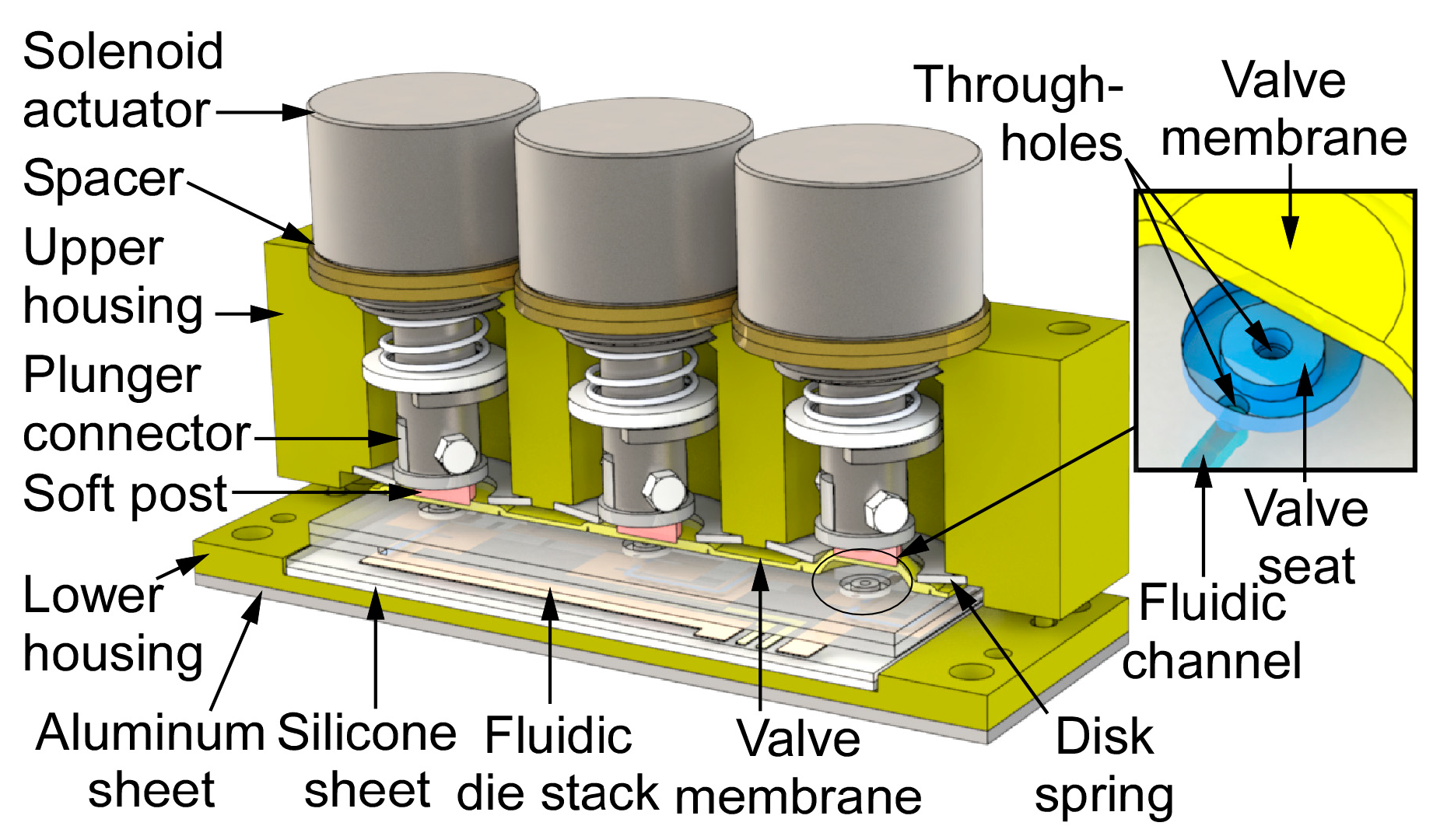


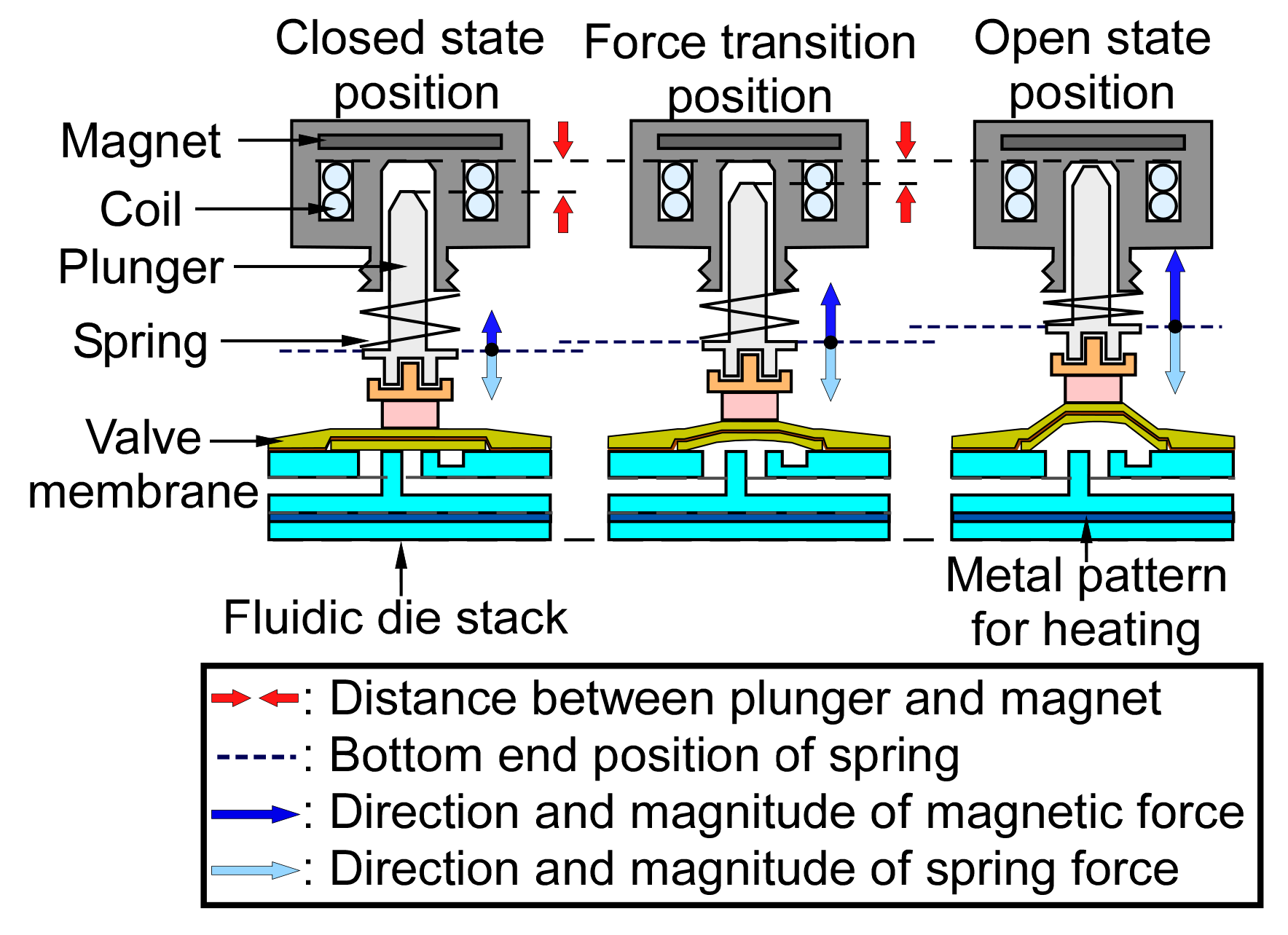

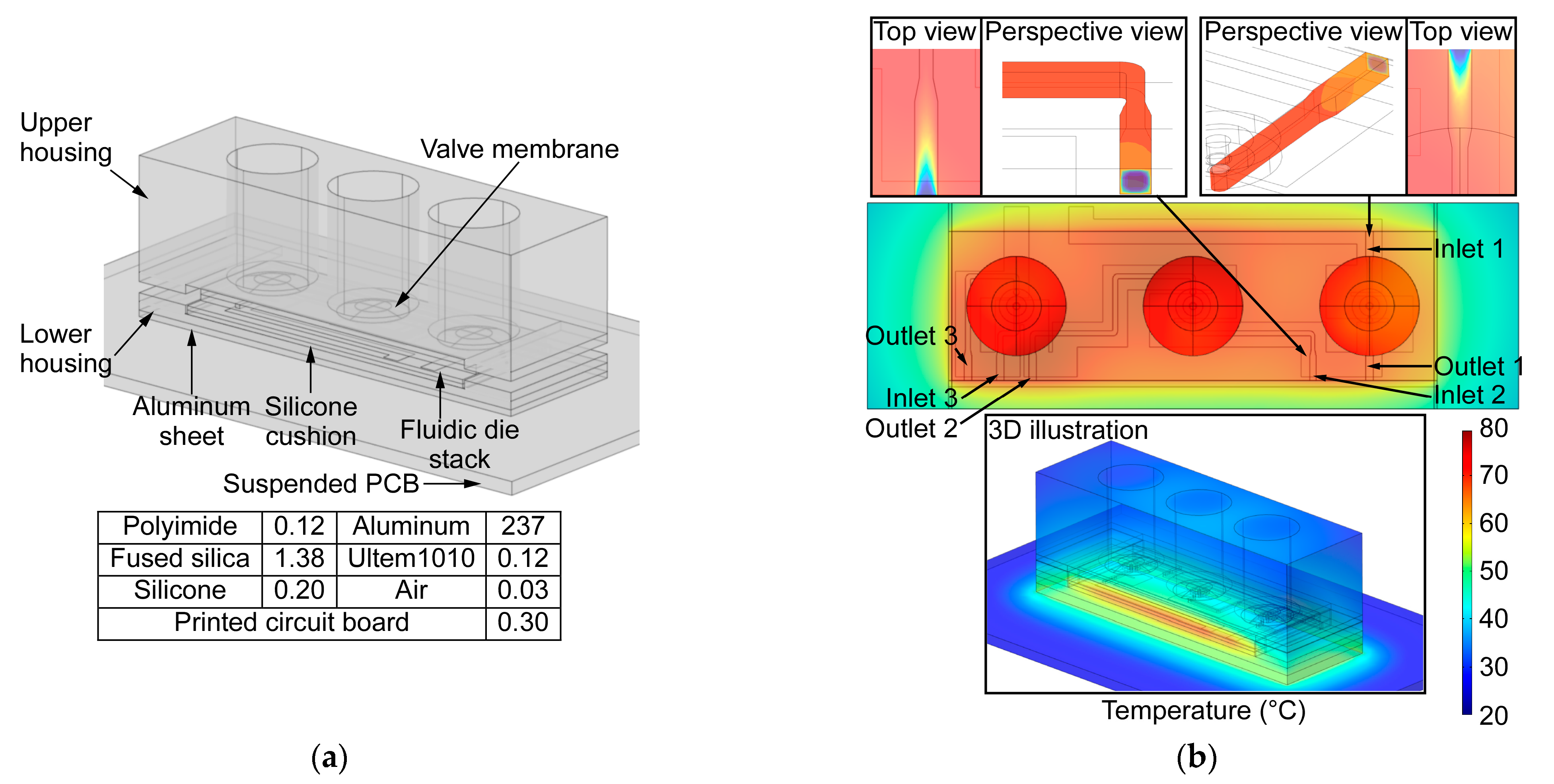

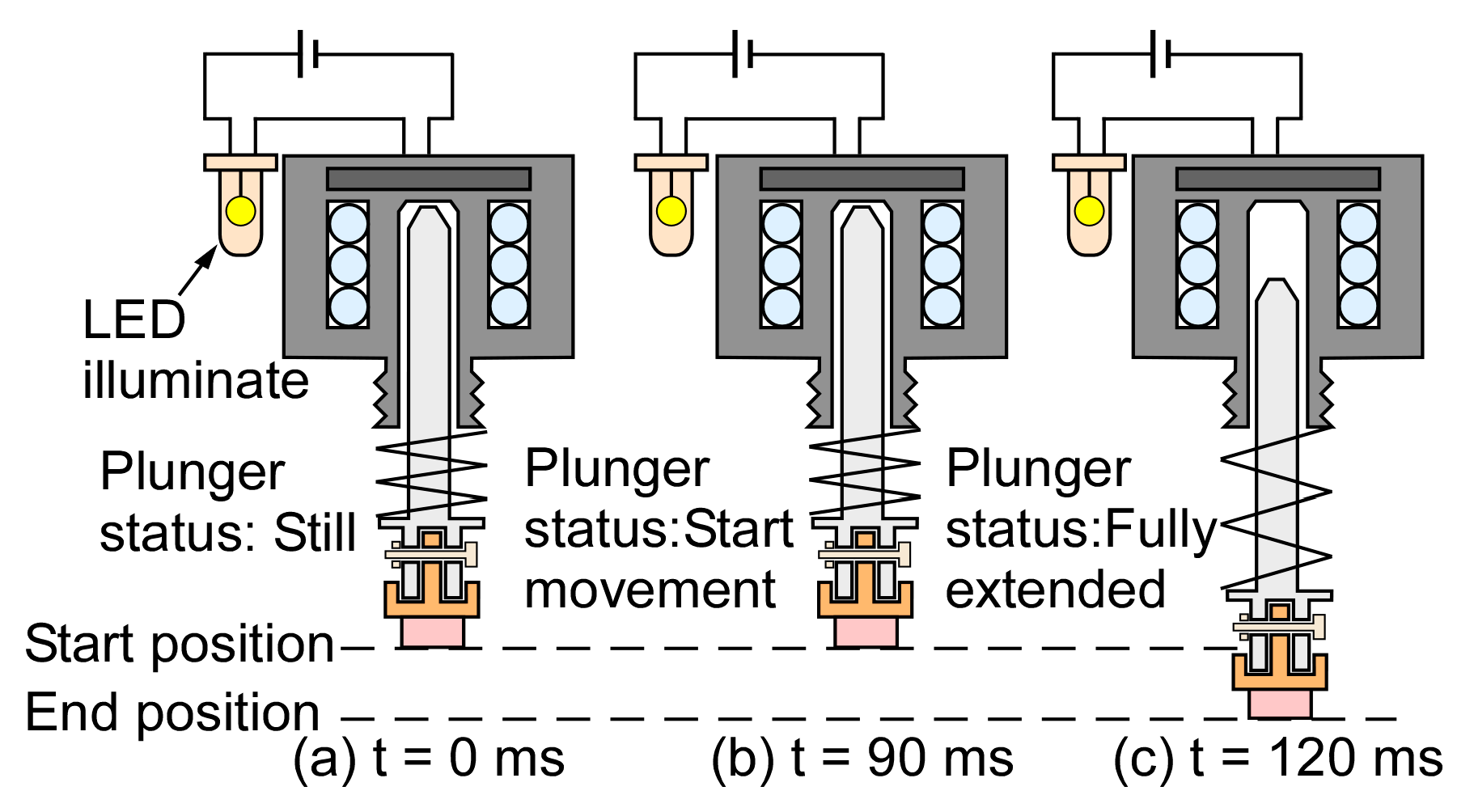





Publisher’s Note: MDPI stays neutral with regard to jurisdictional claims in published maps and institutional affiliations. |
© 2021 by the authors. Licensee MDPI, Basel, Switzerland. This article is an open access article distributed under the terms and conditions of the Creative Commons Attribution (CC BY) license (http://creativecommons.org/licenses/by/4.0/).
Share and Cite
Lu, H.-T.; Qin, Y.; Gianchandani, Y. A Microvalve Module with High Chemical Inertness and Embedded Flow Heating for Microscale Gas Chromatography. Sensors 2021, 21, 632. https://doi.org/10.3390/s21020632
Lu H-T, Qin Y, Gianchandani Y. A Microvalve Module with High Chemical Inertness and Embedded Flow Heating for Microscale Gas Chromatography. Sensors. 2021; 21(2):632. https://doi.org/10.3390/s21020632
Chicago/Turabian StyleLu, Hsueh-Tsung, Yutao Qin, and Yogesh Gianchandani. 2021. "A Microvalve Module with High Chemical Inertness and Embedded Flow Heating for Microscale Gas Chromatography" Sensors 21, no. 2: 632. https://doi.org/10.3390/s21020632
APA StyleLu, H.-T., Qin, Y., & Gianchandani, Y. (2021). A Microvalve Module with High Chemical Inertness and Embedded Flow Heating for Microscale Gas Chromatography. Sensors, 21(2), 632. https://doi.org/10.3390/s21020632





